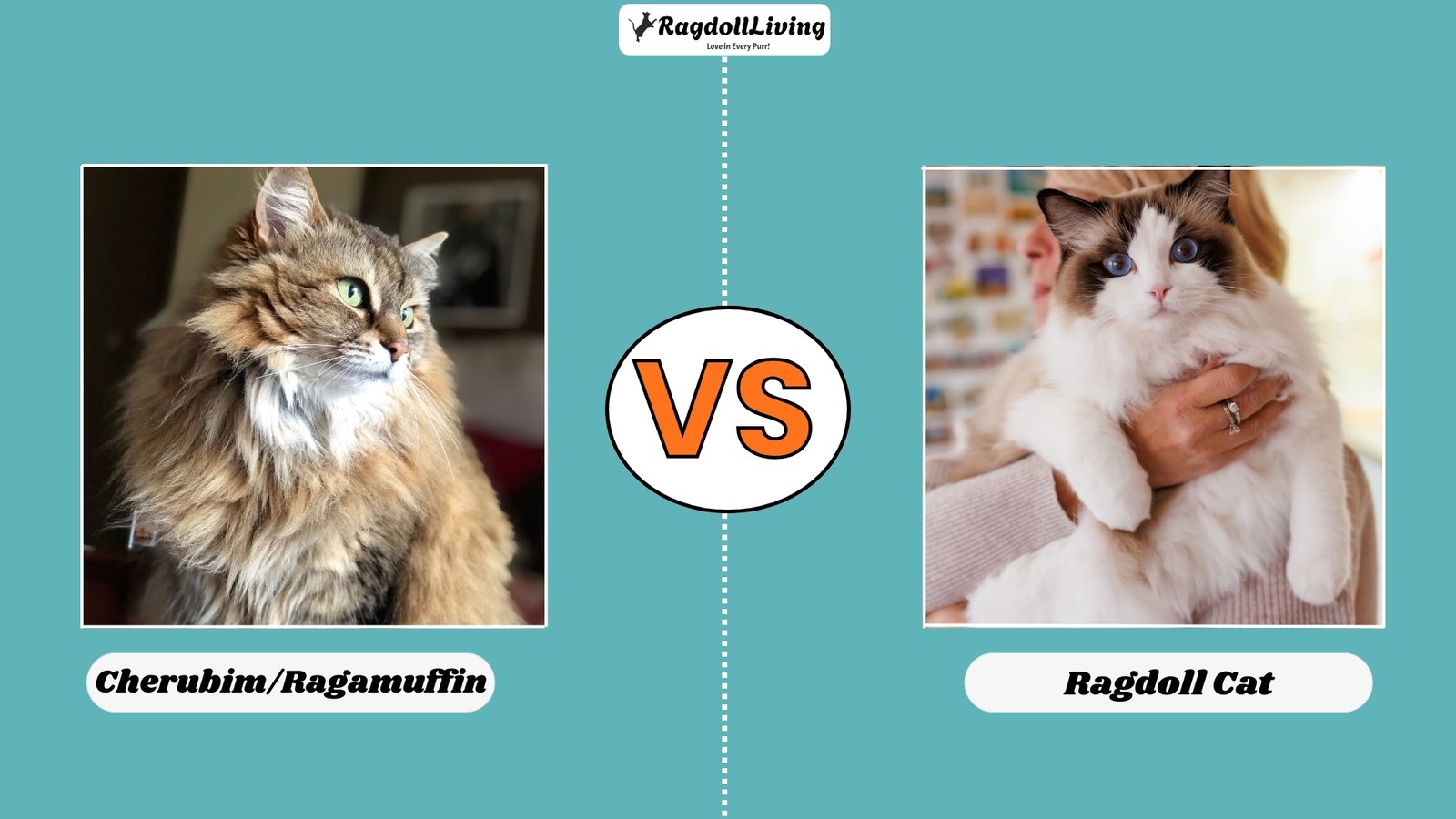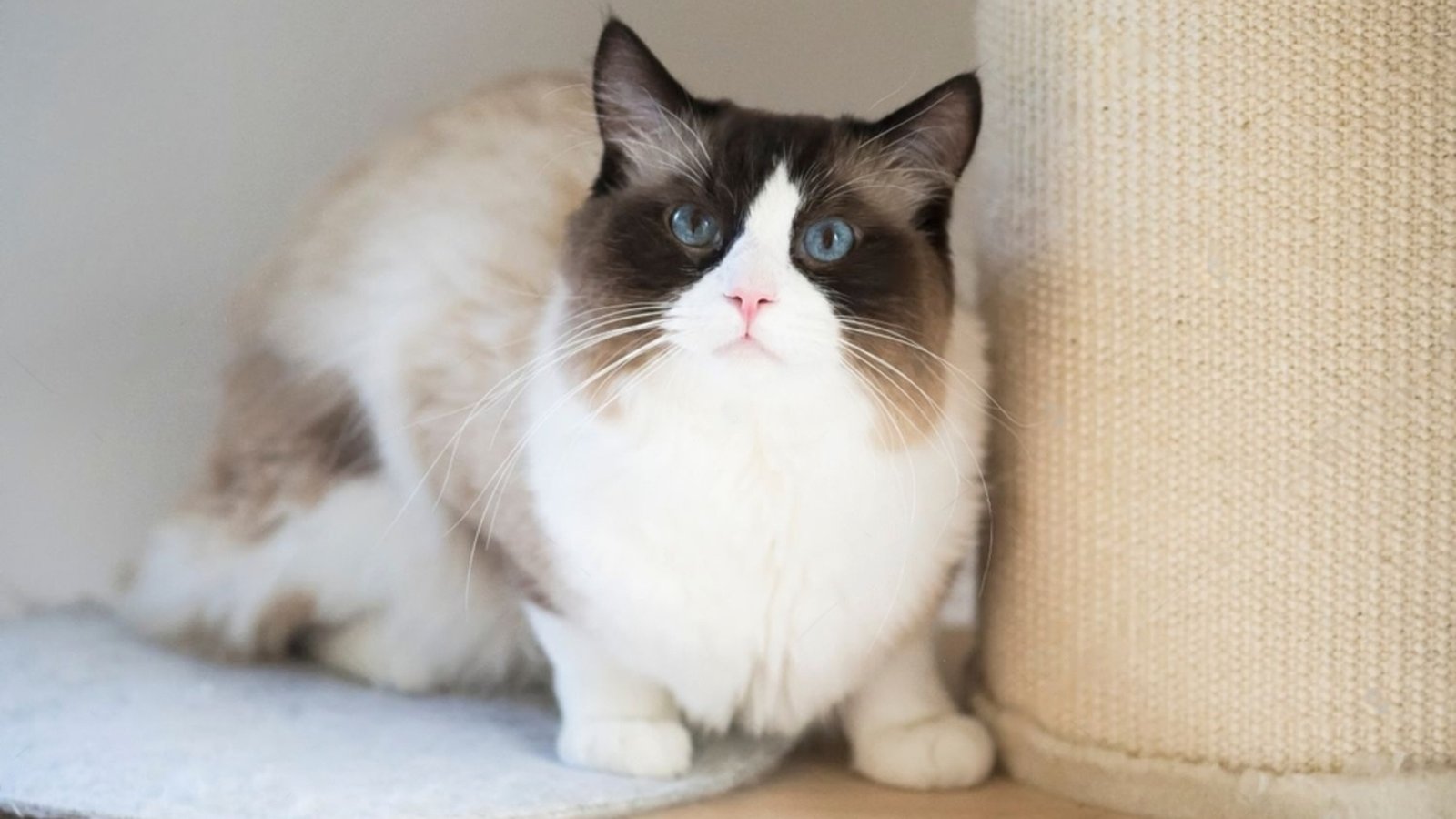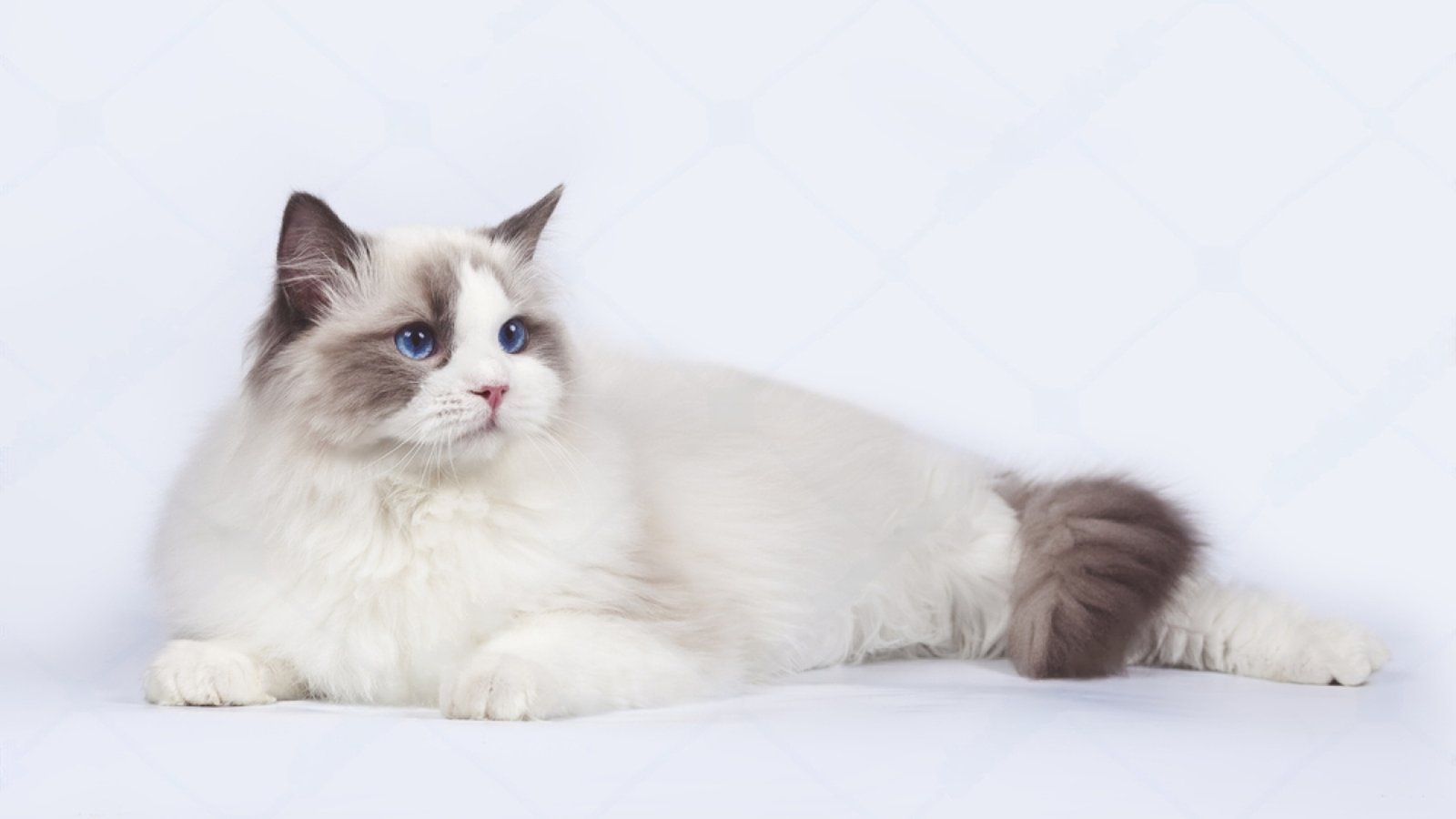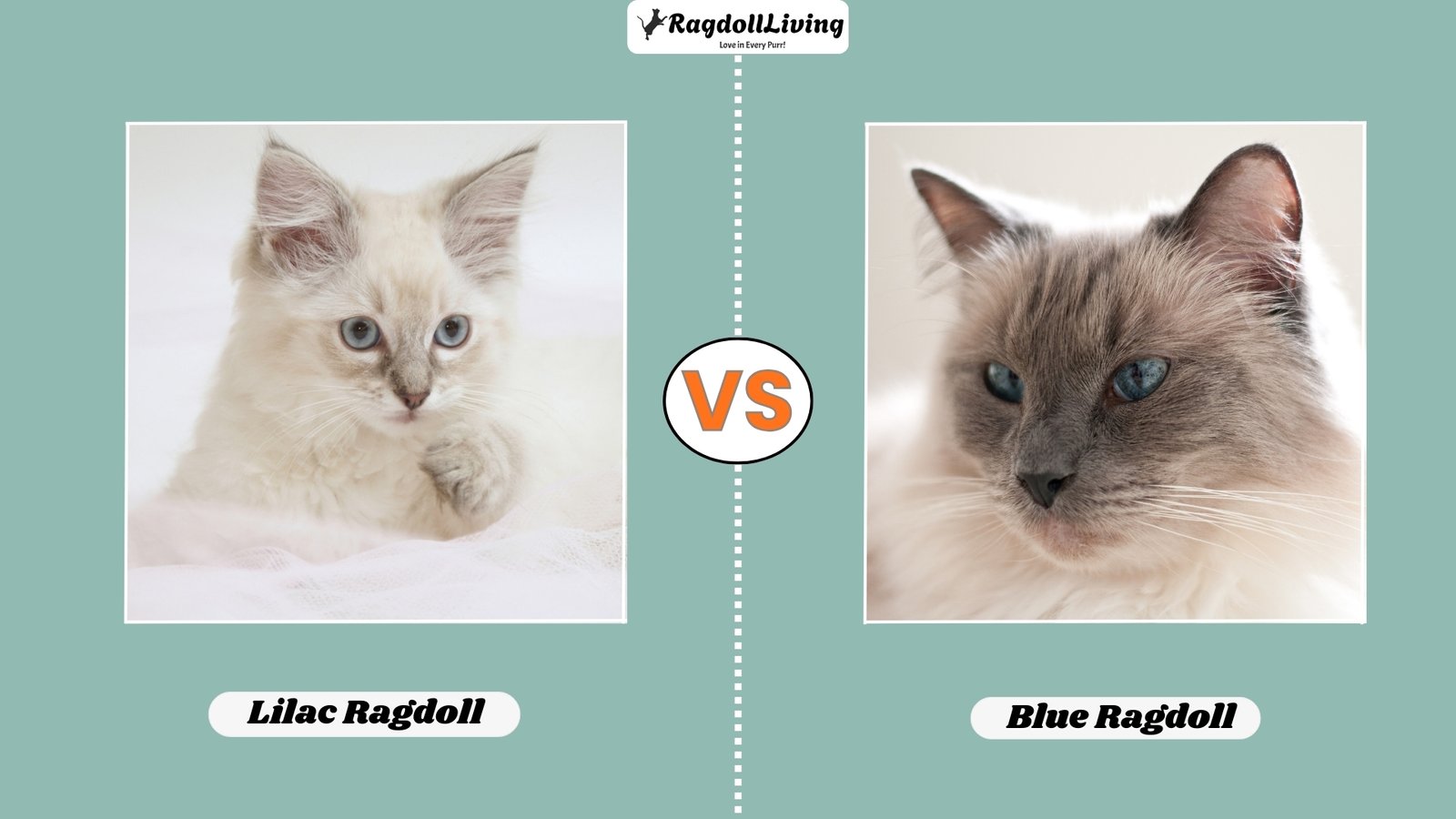Cherubim cats also known as Ragamuffins are offshoots of pedigree ragdolls. Both breeds are genuinely known for being true lap cats, eager to curl up next to you, rabbit-like fur, and politely coping with different homes.
The huge similarities between cherubim/Ragamuffins and ragdoll cats can get many of you confused though. With the right knowledge, it’s way easier to differentiate between the two and decide which one to pick.
Ragamuffin has round eyes, a cheeky face, long-haired coat, and comes in a broad spectrum of colors with no points. Meanwhile, the Ragdoll cat struts with almond eyes, a sleek wedge-shaped face, a semi-long-haired coat, and limited coat colors with darker color points (ears, tail, nose, and paws).
Related Read: Traditional vs Mink Ragdoll Cats
Cherubim vs. Ragdoll – Breed Info
| Cherubim/Ragamuffins | Ragdolls |
|---|---|
| Height: 9-12 Inches | Height: 9-11 Inches |
| Weight: 10-20 lbs | Weight: 10-20 lbs |
| Average Lifespan: 15-18 Years | Average Lifespan: 12-17 Years |
| Origin: Developed in the 1990s through selective breeding by a group that split from Ann Baker’s Ragdoll program. | Origin: Developed by Ann Baker in the 1960s, in California, United States. Thanks, Ann! |
| Grooming Needs: Moderate | Grooming Needs: Moderate |
| Eye Color: Blue, green, odd-eyed, Amber gold | Eye Color: Blue |
| Go Well With: Families with kids, pets, solo, couples | Go Well With: Families with kids, pets, solo, couples |
History Of The Cherubim/Ragamuffin Cat
The history of the Cherubim cat is pretty closely tied to its cousin, the Ragdoll. Ann Baker, In the 1960s first produced the Ragdoll breed in California, United States. Fast forward to 1994, some breeders crossed Ragdoll cats with Persians, Himalayans, and domestic long-haired cats for a more diverse gene pool.
The result was a Ragamuffin cat which was pretty resemble to the Ragdoll but with a few stubble exceptions that obviously you’ve seen in the table and will notice below too. The Ragamuffin gained recognition as an official breed by the United Feline Organization in 1994 and by the American Cat Fanciers Association in 2003.
The Governing Council of the Cat Fancy in the UK recognized the Ragamuffin cat breed in 2009. The Cherubim name is more of an affectionate or informal term used alongside Ragamuffin and isn’t a separate breed up for independent recognition.
Cherubim/Ragamuffin Appearance
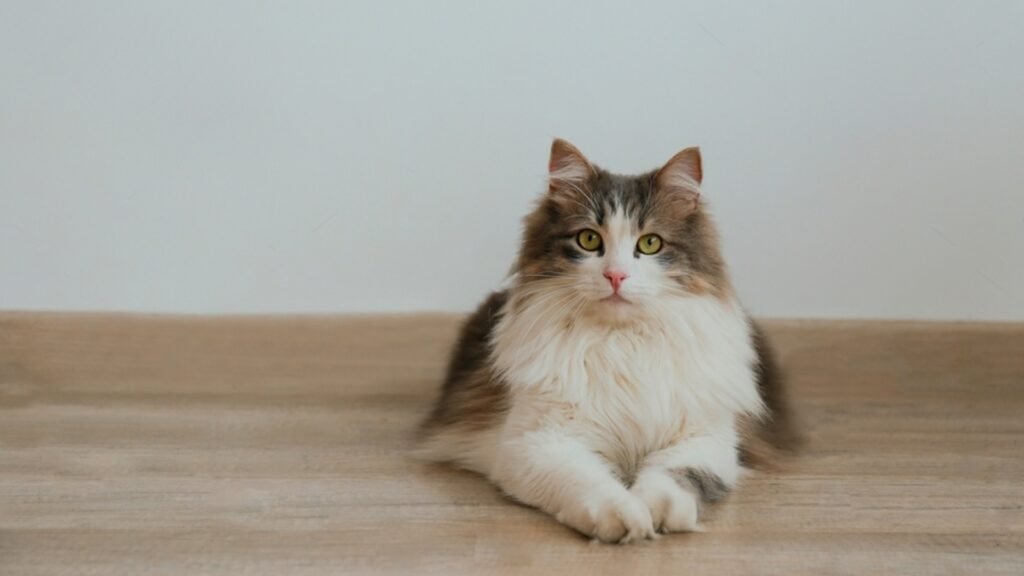
As of the larger domestic cat breed, adult Cherubim/Ragamuffin could nearly grow 33 inches in length. They have sturdy body structures more like their ancestry ragdolls characterized by broad chests and shoulders. Their legs are heavily boned ending in large sweet paws that are in proportion with their body.
Their coat is so smooth, that it feels like petting a cloud disguised as a rabbit. Cherubim/ragamuffin eyes are oval at the top and round at the bottom, much like a walnut. Tufted ears add to their charming look. The most noticeable appearance variation when it comes to Cherubim vs. Ragdoll is the color scheme.
Cherubim/Ragamuffin Personality & Temperament
Cherubim/Ragamuffin cats are often described as dog-like in their devotion to their families. Due to shared ancestry with ragdoll cats, they get on with whatever you’re doing. It’s normal to see them sitting on your lap while you enjoy a cup of tea, meowing softly to greet you when you come home after work or curled up beside your laptop while you work or study. If you’re up to it, you can often pick it up and snuggle in without any fuss – they’re that easygoing.
Unlike ragdolls who like to go limp and stay lazy, Ragamuffins are kinda more social, get along well with other pets and kiddos, and can even be a little goofy sometimes. They tune in with your emotions and are empathetic, accommodating, and loyal to the end.
Although they’re not typically high-energy cats and are content to stay off the ground most of the time, they do scratch furniture and like to participate in interactive play. Place scratching posts near the sofa, furniture, door, and condo to redirect their natural behavior to it.
Things To Know When Owning Cherubim/Ragamuffin
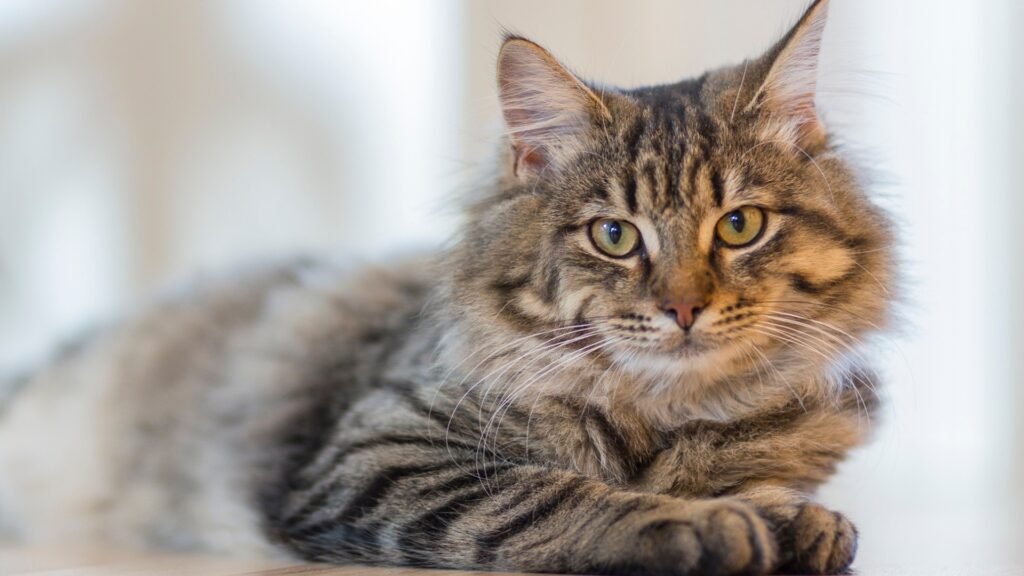
Nutrition
Since cherubim cats are slow to mature, you’d see their kitten-like behavior until they’re around 4 years old. Usually, adult female Cherubim can weigh around 10-15 lbs and males around 15-20 pounds.
Turns out, their nutritional needs would change over time as they grow up. High-quality cat food with a good balance of animal protein, fats, and carbohydrates should be part of every cherubim cat’s diet. Consult your vet about the best diet plan and prefer wet food over dry one to maintain healthy weight.
Grooming
Cherubim/Ragamuffins have medium to long plush coats with longer fur around their neck that needs low maintenance. Their coat won’t mat easier though tend to moderate to high shedding which would require a few minutes of brushing or combing once or twice a week.
Regular grooming not only keeps your ragamuffin cat looking great but also helps eradicate all those loose, dead hairs that would otherwise end up on your furniture, clothes, and all over the floor. Trim their claws every two to three weeks and brush their teeth daily or at least once per week with cat-friendly toothpaste to prevent dental issues.
An occasional bath is okay, but only necessary if your cat gets soiled or into something nasty. Don’t dare to use human shampoo or even kid’s mild shampoo, rather pick a shampoo that is specifically labeled for cat use.
Exercise & Training
As mentioned earlier, Cherubim/Ragamuffins are low to moderate-energy cats but don’t take all that lounging around for granted. They need regular playtime to keep them in shape and entertained.
Toys like jingle balls, string toys, fetch, cat dancers, or puzzles will do wonders for your ragamuffin’s physical and mental well-being. They even tolerate leashes, you can take them out sometimes it turns out. However, be extra careful since Ragamuffins are naïve cats, they can be an easy target for predators or stray cats.
When it comes to training, cherubim/Ragamuffin cats are bright and more sociable love learning new things, and can be trained pretty easily compared to ragdolls. Clicker training can be particularly effective with these breeds. Besides, puzzle feeders, hiding treats for them to find out, and rotating their toys can help keep their minds active and prevent boredom.
Health Care
For the most part, Cherubim/Ragamuffin cats are healthy breeds, but like all cats, they are susceptible to specific health issues. Two conditions to be aware of are PKD (Polycystic Kidney Disease) and Hypertrophic cardiomyopathy (HCM). To be on the safe side and obviously, for the sake of your kitty, pick the right vet ahead of time and perform regular check-ups for early diagnosis if any.
Suitability
If you have a busy lifestyle and want a low-maintenance cat around that wouldn’t require much of your lookout, then cherubim/ragamuffin cat is NOT for you. They are social and would need enough attention to thrive comfortably.
You can’t leave them alone for more than 8 hours or in worst-case scenarios, 24 hours at a stretch. They make very much great family pets since they adjust to different environments and indoor-only life well. They’re not overly demanding either in terms of exercise but do enjoy interactive play sessions with their humans and engaging cat toys.
Fun Activities For Cherubim/Ragamuffin
- Play with interactive puzzle toys or feather wands
- Being petted & groomed
- Learning simple tricks like clicker training
- Cardboard boxes or paper bags for hide-and-seek
- Lounging on cozy perches near windows
- Using scratching posts
History Of Ragdoll Cat
What we know about the Ragdoll cat’s origins traces back to the 1960s in California, United States. Ann Baker, a breeder was the one who first created ragdoll cat breed (thanks Ann!). The ragdoll gets its name from its incredibly relaxed temperament, it goes all limp when you pick it up, much like a ragdoll.
Baker claimed she had bred a white-longhaired female domestic cat named Josephine with seal mitted male, Daddy Warbucks, and a solid black male, Blackie. The resulting offspring Temperament inherited their mother’s laid-back nature which is what Ragdolls are known for.
Over the years, the breed gained popularity heavily among homeowners due to its gentle disposition and striking appearance. In June 1979, the TICA (The International Cat Association) feline registration authority accepted the Ragdoll breed for championship status. Although, ragdoll was accepted later by the CFA (Cat Fanciers’ Association) in 1993.
Ragdoll Cat Appearance
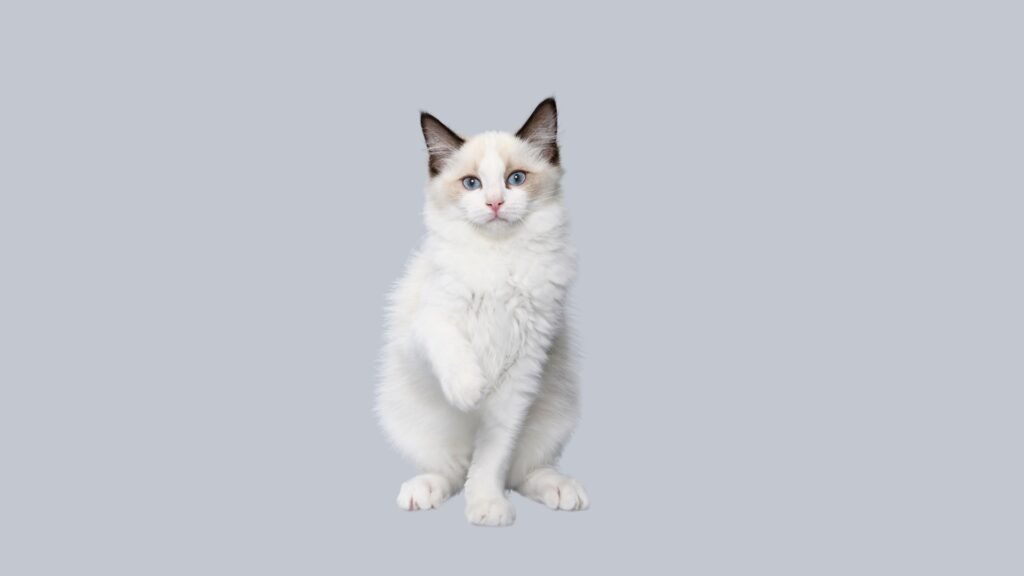
The key to Ragdoll Beauty is their beautiful blue eyes and semi-long plush coat which can come in 4 different patterns (bicolor, van, mitted, and colorpoint), and the pattern further comes in six different colors (seal, blue, chocolate, lilac, red, and cream).
Ragdoll’s fur is a remarkable feature of this cat breed; they are non-matting and don’t shed as much as other cats do. Like Cherubim/ragamuffin cats, Ragdolls develop slowly and hit maturity at around 4 years. Unlike Cherubim cats, ragdolls are exclusively pointed cats. They have a darker pigment on their ears, tail, face, and legs and the rest of the body is lighter.
Like Ragamuffins, their body type is substantial, with males typically larger than females. The head is broad and wedge-shaped, with rounded contours, medium-sized ears, full cheeks, and oval-shaped eyes.
Ragdoll Cat Personality & Temperament
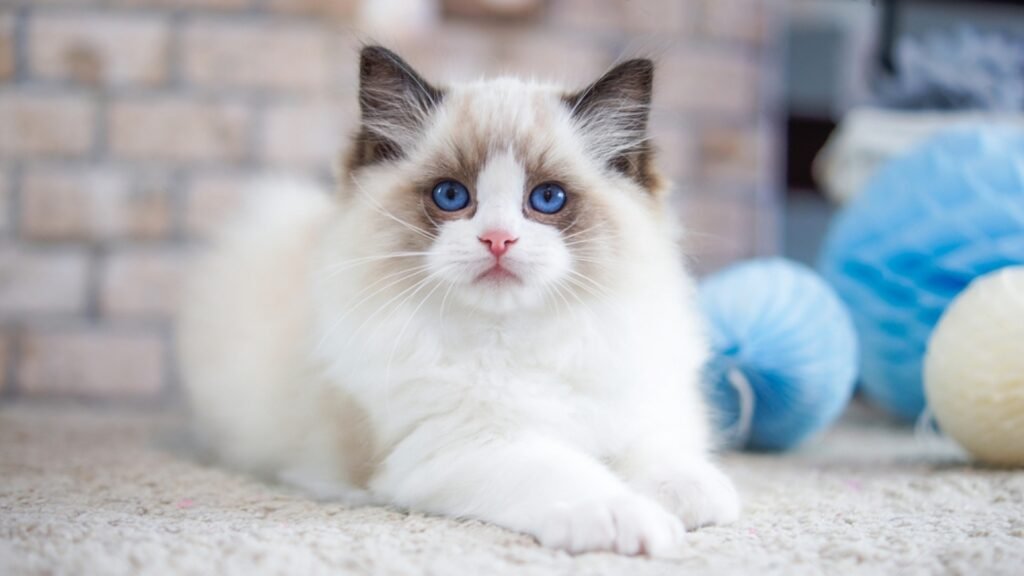
We can’t stress enough how placid, laid-back, and affectionate Ragdoll cats are. They tolerate being held by kids and adjust to new environments very well as long as you give them plenty of love and attention. The kittens will follow you around the house and barely miss the chance to snuggle on your lap.
Ragdoll cats’ energy levels normally remain low. You’ll see them snoozing most of the time over their favorite spot and they get along with dogs nicely. If you get your kitty accustomed to playtime from an early stage, they’ll surely come running if you pull out one of their favorite toys and curl up next to you.
Things To Know When Owning Ragdoll Cat
Nutrition
Naturally, both ragamuffin and ragdoll are large size breeds and their diety needs are pretty same too. Similarities make sense cause after all ragamuffin/cherubim cat is a crossbreed of ragdoll. You need to feed them a little extra compared to usual cats though.
Avoid overfeeding since it could make them fat. Their nutritional needs largely depend on the life stage they’re in, their sex, and obviously their activity level. Ragdoll cats’ diets should be meat-based and rich in protein to support coat luster, muscle, and tissue development.
The most accurate method of knowing whether you’re feeding the right amount to your ragdoll (and if they’re burning it off properly) is to talk with the vet you trust most and ask for diet recommendations.
Grooming
Unlike Cherubim/ragamuffin cats, the ragdoll coat is medium-length with no undercoat that demands low but frequent grooming sessions. Their coat doesn’t usually get tangled and caring for it is simple.
Use wide-tooth combs or soft brushes twice a week to keep your ragdoll coat in top shape. Though they’re naturally prone to shedding, it’s usually not excessive. As a Ragdoll owner, you’ve to tolerate some fur around the house – they do shed a certain amount, especially during spring and fall, or when there’s a dramatic humidity change.
All cats, including ragamuffins/cherubim and ragdolls scratch furniture so it’s best to cut their nails out and put scratching posts near their favorite hangout spots. They’re easy to pick up and throw away when worn out.
To prevent plaque build-up, brush their teeth ideally once per day. If that’s not possible, aim for at least a few times a week. Cats hate water so do ragdolls, they’re easygoing, but not when it comes to bathing. It could put them under stress if your kitten isn’t accustomed to water. That’s why we recommend occasional bathing with cat-friendly shampoo only when necessary and not more than once a month.
Related Read: How To Brush Your Ragdoll Cat
Exercise & Training
Obesity is a major concern in ragdolls since they like to relax a lot and the icing on the cake is they already weigh a lot. In this sense, neglecting exercise especially as they get senior could prove to be a big mistake.
Where cherubim/ragamuffin cat is more sociable, ragdolls are pretty easy to train and quite intelligent though, you need to first take over their trust and love your ragdoll has for you. Any page ball could help if the bonding between you two is strong enough.
Like any other cat, they can learn tricks and love playing hide & seek with them. Put time aside for playtime with your ragdoll cat every day and play fun games like fetch, and puzzle, or use a clicker for training. Feather toys and catnip-infused toys are usually big hits too.
Health Care
Mainly there are a few potential health concerns your ragdoll cat is prone to so it’s best if you keep an eye out for them lately. Ragdolls tend to have an increased risk of developing Hypertrophic cardiomyopathy (HCM), where your Ragdoll’s heart muscle becomes thick.
As per the estimated numbers, 30% of ragdolls carry a genetic mutation which is the core reason for HCM. Other health issues to keep an eye out for are bladder stones and bad gum. Besides, vaccinations ought to be kept up-to-date. In cats, core vaccines start around six to eight weeks old, with booster shots every year or every three years.
Once they’re mature, be careful not to overfeed them. Stick to controlled meals and don’t feed them dry food solely. Instead, you could offer a mix of dry and wet food, or wet food only if that suits their living situation better (vet’s suggestion is a must here). We recommend picking the right vet ahead of your ragdoll kitty’s arrival and at least once a year complete check-up even if your ragdoll cat doesn’t like traveling or visiting the vet.
Related Read: How To Choose The Right Veterinarian For Ragdoll Cat
Suitability
Ragdoll cat is meant for individuals and families who seek a family-friendly, laid-back cat breed to add to their home. They thrive on being petted and are famous for their tendency to go limp when held, and likewise, Cherubim/Ragamuffins share a chilled-out temperament.
Despite being loyal and loving, ragdolls don’t do well when left alone for longer periods (Over 12 hours or a day). The same text we’ve written for cherubim/ragamuffin cats goes for ragdolls. If you’re busy, live solo, or don’t have anyone behind to look after your cat, don’t get a ragdoll.
Fun Activities For Ragdoll Cats
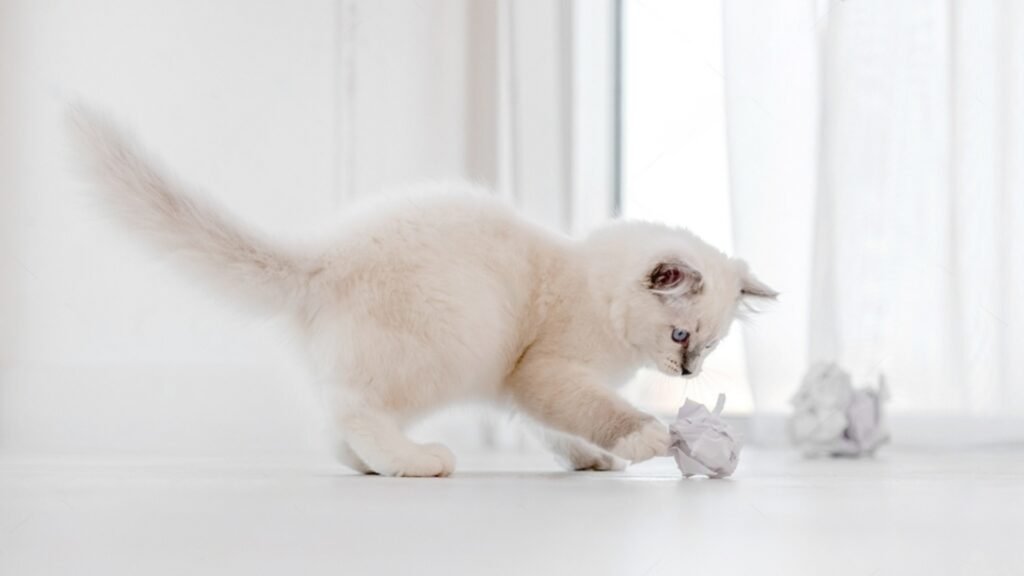
- Chase laser pointers or string toys
- Cuddling & being petted
- Lap time
- Soft plush toys for gentle fetch or carrying around
- Watching birds from a comfortable window perch
- Climbing cat trees or scratching posts
Cherubim/Ragamuffin vs. Ragdoll: Which Cat Breed Is Right for You?
In terms of Cherubim vs Ragdoll, there’s nothing major in temperament, size, and weight difference. Both breeds are known for their peaceful and laid-back personalities and can reach around 20 lbs of weight and around 10 inches of height. They love to be around their humans and participate in day-to-day activities. Though, where the difference comes in is cherubim/ragamuffins come in all sorts of colors and patterns, unlike solid or pointed patterns in ragdolls.
Besides, the cherubim/ragamuffin cat is kinda more social, pretty rare, and tends to live longer whereas ragdoll cats are docile and look marvelously adorable with blue eyes but not that much outgoing. The answer to which cat breed is better, whether cherubim/ragamuffin or ragdoll comes down to your priority since there isn’t much difference in personality, you can pick any from the two or both.
Wrapping Up…
All in all, both the cherubim/ragamuffin and ragdoll are incredibly charming, easy-going cat breeds you can ever come across. Cherubim/Ragamuffin is in fact pedigree cousin of the ragdoll cat breed which comes after ragdoll cats were bred with Persian, himalayan, and domestic long-haired cats. Since they both are great, big dog-like cats with generous attitudes, you can’t really go wrong with either of them. Hopefully, our detailed guide has given all the differences and similarities between cherubim/ragamuffin and ragdoll cats as well as how to care for them adequately.
Written By: Usman Malik | Reviewed By: Ali Abbas | Fact Checked By: Aqib Zulfiqar



